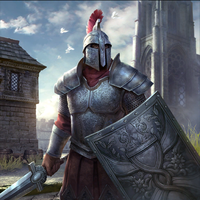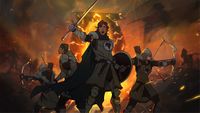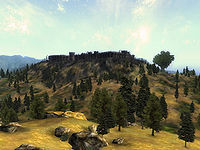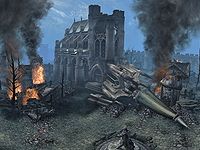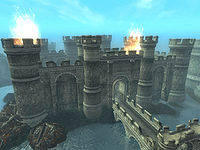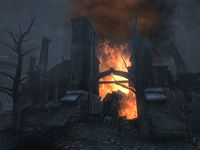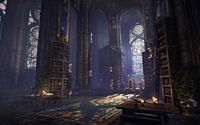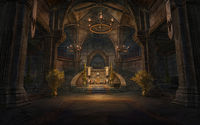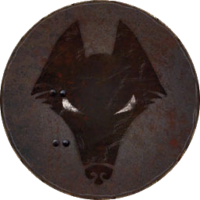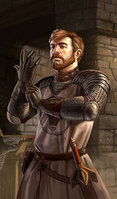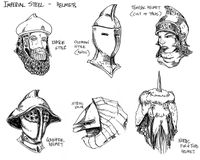Lore:Kvatch
| Kvatch | |
|---|---|
| Type | Settlement |
| Continent | Tamriel |
| Province | Cyrodiil |
| Region | Gold Coast |
| Demonym(s) | Kvatchian, Kvatchi[1] |
| Appears in | Oblivion, Oblivion Mobile, ESO |
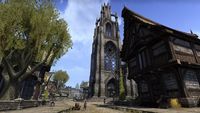
Kvatch is a Colovian city in the hinterland of the Gold Coast of Cyrodiil, located between Anvil and Skingrad. It is built atop a large bluff, raising the city above the surrounding forests. Its coat of arms is a black Dire Wolf on a grey background.[2] The city is home to an arena, the imposing Kvatch Castle, and the Great Chapel of Akatosh. County Kvatch extends far to the northwest, up to the Brena River at the border of Hammerfell.[3] The people of the city wear turban-like helmets with chainmail.[1]
Contents
History[edit]
First Era[edit]
In the early days of Cyrodiil, in the wake of the Alessian Doctrines, there were three lords that formed a regency council over the Kingdom of Kvatch circa 1E 361, one of them being Lord Nunex Faleria.[4] During the fifth century of the First Era, the kingdoms of Kvatch and Skingrad were rivals. Their skirmishing ended in 1E 472, during which time Kvatch was under rule of King Justinius. The king's daughter Belene was wed to Prince Rislav Larich of Skingrad, presumably to make peace between the two kingdoms. Towards the end of the fifth century, the Kings of the Colovian West joined with Kvatch and Skingrad to resist the Alessian army and its Reform. This open rebellion helped prompt Clan Direnni's excursions into Cyrodiil and ultimately the collapse of the Alessian Empire.[5]
Second Era[edit]
The Order of the Hour was revived in Kvatch by the warrior-priest Cavor Merula in 2E 432[6], and were instrumental in ending the Order of the Black Worm's presence in the city in 2E 437. Following two years of red wheat blight that devastated harvests in 2E 467, Gruff Bojour led an angry mob of citizens to the steps of the Cathedral, where half of them were slaughtered by the Order's warrior-priests.[7] A few years later in 2E 480, the Order defended Kvatch against an army of marauders led by the Orc Baz Swordbreaker. In 2E 576, Count Varen Aquilarios led the Second Legion against Emperor Leovic, leaving his nephew Carolus Aquilarios in charge. Carolus, with just a single cohort of the Second Legion, successfully defended Kvatch against attacks from Count Ephrem Benirus of Anvil, leaving the port city weakened and ripe for Fortunata ap Dugal to capture. Primate Artorius Ponticus also began working against Carolus.[8][9]
When Fortunata captured Anvil in 2E 579 and declared herself Provincial Governor of an independent Gold Coast, Carolus refused her request for Kvatch to join her and continued to swear fealty to Varen. After the Soulburst and Kvatch's increased isolation, Fortunata stepped up a campaign of disrupting trade and travel that culminated in Fortunata attempting an annexation of Kvatch with the Anvil Guard. This was a feint however, and Kvatch's cohort was ambushed and destroyed after engaging Fortunata's forces in what has become known as the 'Gottshaw Massacre'.[9] After the assassination of Fortunata and Artorius Ponticus by the Dark Brotherhood in 2E 582, Carolus emerged as the dominant power in the region.[10]
At this time, an abandoned Dark Brotherhood sanctuary was located outside the city walls to the south. Built into the Foundations of Kvatch itself, this ancient complex had to be abandoned by the Dark Brotherhood after a subterranean collapse caused it to connect up to a massive natural cavern.[11]
Third Era[edit]
Kvatch was a major settlement when it was sacked by the Camoran Usurper in 3E 249.[12] At the center of the city stood a statue of Antus Pinder, a hero who led the defense of the city against an unspecified superior force. Despite being defeated gravely, the statue was erected to remember his courage and spirit.[13]
By the late Third Era, the ruling family of Kvatch was the Goldwine lineage. A conflict over inheritance caused the death of both sons of Count Ormellius Goldwine in 3E 432, causing a short period of unrest in Kvatch.[14] In 3E 433, the Dunmer saint, Jiub, moved to Kvatch to begin work on his autobiography.[15]
Not long after the assassination of Uriel Septim VII, the city was razed to the ground by Daedra as the opening move of the Oblivion Crisis, leaving Kvatch with no count. Many of its citizens were also killed, and those who survived either fled into the countryside or congregated at a refugee camp at the foot of the bluff. Among the survivors was Martin Septim, who escaped the city after the Hero of Kvatch closed the last remaining gate to the Deadlands (the feat that would give them their auspicious title). With all the Oblivion Gates sealed, the Kvatch city guard were able to enter the ruins and retake Kvatch Castle with the aid of the Hero and the Imperial Legion. Kvatch provided what few men it could afford to aid in the defense of Bruma later that year.[16]
Fourth Era[edit]
At the opening of the Fourth Era, following its liberation from the Daedra, the city was uninhabited and only the chapel and castle remained standing.[16]
The city had been restored to prominence by the time the Great War broke out in 4E 171.[17][18]
Known Rulers[edit]
- The First Era
- The Second Era
- Count Varen Aquilarios (ca. 2E 576)[20][8]
- Count Carolus Aquilarios (ca. 2E 582)
- The Third Era
- Count Ormellius Goldwine (ca. 3E 433)
Gallery[edit]
-
City ruins during the Daedric occupation circa 3E 433 (Oblivion)
-
The interior of the Cathedral of Akatosh circa 2E 582 (ESO)
-
The interior of Castle Kvatch circa 2E 582 (ESO)
See Also[edit]
- For game-specific information, see the Oblivion and Elder Scrolls Online
 articles.
articles.
References[edit]
- ^ a b Kvatchi Style helmet concept art
- ^ Guide to Taming Dire Wolves — Shelga gra-Bur, Beastmaster of Kvatch
- ^ Oblivion's Map of Cyrodiil
- ^ a b c The Lost Fort Faleria
- ^ Rislav The Righteous — Sinjin
- ^ Statue of Cavor Merula
- ^ Order of the Hour — Exordor Vasidius, Sermonizer, Priest of Akatosh
- ^ a b The Wolf and the Dragon — Midara Salviticus, Historian, University of Gwylim
- ^ a b The Wolf and the Pirate Queen — Midara Salviticus, Historian, University of Gwylim
- ^ Events of ESO Dark Brotherhood
- ^ The Erstwhile Sanctuary description in ESO
- ^ The Refugees — Geros Albreigh
- ^ Loading Screen in Oblivion
- ^ Pocket Guide to the Empire, 3rd Edition: The Seat of Sundered Kings: Cyrodiil — Imperial Geographical Society, 3E 432
- ^ Saint Jiub's Opus — Jiub
- ^ a b Events of Oblivion
- ^ The Great War — Legate Justianus Quintius
- ^ Rulings text in Castles
- ^ Rislav The Righteous — Sinjin
- ^ Varen's Wall — Midara Salviticus, Historian, University of Gwylim

